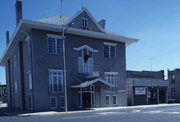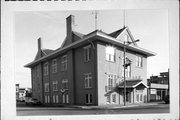Property Record
117 N 1ST ST
Architecture and History Inventory
| Historic Name: | Concordia Opera House |
|---|---|
| Other Name: | B.P.O.E. Lodge No. 666 |
| Contributing: | Yes |
| Reference Number: | 74634 |
| Location (Address): | 117 N 1ST ST |
|---|---|
| County: | Jefferson |
| City: | Watertown |
| Township/Village: | |
| Unincorporated Community: | |
| Town: | |
| Range: | |
| Direction: | |
| Section: | |
| Quarter Section: | |
| Quarter/Quarter Section: |
| Year Built: | 1888 |
|---|---|
| Additions: | 1917 |
| Survey Date: | 1986 |
| Historic Use: | theater/opera house/concert hall |
| Architectural Style: | Italianate |
| Structural System: | |
| Wall Material: | Brick |
| Architect: | William Waters |
| Other Buildings On Site: | |
| Demolished?: | No |
| Demolished Date: |
| National/State Register Listing Name: | Main Street Commercial Historic District |
|---|---|
| National Register Listing Date: | 6/2/1989 |
| National Register Multiple Property Name: |
| Additional Information: | This building was constructed for the Concordia Music Society in 1888. In 1917 it was remodeled into the Elk's Club. The Concordia Music Society was formed in 1862. The group was largely German and was also known as the Watertown Sangerverein. What was particularly distinctive about Concordia was that it was a very active performing group. The members presented concerts, operettas, operas, and other noted "high-brow" entertainment. The group was active in the state-wide sangerverein movement and at least three times Concordia hosted music conventions or sangerfests in Watertown. In 1866 the group acquired an old church building and moved it to Second and Cady streets, enlarged it, and created Music Hall. In 1874, the group acquired an island in the Rock River. They named it Concordia Island and it was a popular recreation spot during the turn of the century years. Edward J. Brandt, a local banker and industrialist, and his wife, Thekla, were particularly talented and active members of the Concordia Society during the late nineteenth century. When Music Hall burned in 1844, Brandt led the group in constructing the impressive Concordia Hall at this location. The Brandts left the group shortly afterward, but Concordia continued to hold performances of their group and other groups in this hall until the 1910s. In 1917, the Elks purchased the hall and remodeled it into their meeting place ever since. This building has historical interest as the second home of the Concordia Music Society. The Concordia Music Society was the most important of the musical groups in Watertown. It was an active performing group that lasted over 50 years. It represented the love of music fostered by the German immigrants who settled in Watertown. For a community the size of Watertown, it took a unique blend of people to operate such a group in the nineteenth century. Many of the German immigrants in Watertown were middle class well-educated people, forced from their country by unpopular political beliefs of poor economic conditions. Used to high quality musical entertainment in their native country, they fostered such entertainment in their new country. Because this building is the only resource left that is directly associated with the Concordia Society, except Concordia (Tivoli) Island, it is important to Watertown's history of entertainment and performing arts and German settlement. It is not individually significant, though, since the 1917 remodeling resulted in a loss of integrity. But enough of the old building is evident so that it remains contributing within the historic district. The fact that the Elk's Club, a long-time fraternal group in twentieth century Watertown, has been in the building since 1917 also adds to the contributing nature of this building in the Main Street Commercial Historic District. Originally built in 1887-1888 and extensively remodeled in 1917, the Concordia Opera House exhibits a hip roof with broad overhanging eaves, gabled dormers on all sides of the roof, and an elevated foundation. A variety of window treatments characterize the plain brick surfaces. A large multipaned window with triangular pediment shaped window head is located in the center of the facade while straight projecting window cornices over multipaned windows featuring transom window elements characterize the remainder of the facade and the first bay of the side elevations. Segmental arched, multipaned windows are featured on the upper story of the side elevation while rectangular, multipaned windows are on the lower story. An arched entrance with a painted arched overlight and sidelighted, double-leafed door covered by a gabled door hood as well as shallow iron balconies under the long second story windows further characterize the facade. The original architectural character of the Concordia Opera House was altered considerably when it was remodeled in 1917. Originally the Opera House featured a red brick and white stone biochromatic exterior characterized by large round arched windows and entrances and an articulated center bay featuring a large oriel window. The building was altered further by the addition of the broad overhanging eaves and more recently by the application of paint to red brick surface. Originally featuring an open staircase and balcony in the entrance, the interior of the building has been altered completely. Originally the historic Concordia Hall exhibited the polychromatic exterior associated with the Victorian period, arched entrance, large bay window located in the center of the facade. In 1917, the building was altered greatly during an extensive remodelling project during which the Concordia Hall's appearance became even more eclectic characterized mainly by th ebroad overhanging eaves associated with the Prairie School popular durng the period. Although the Concordia Hall can no longer meet the criteria for National Register eligibility, the building contributes to the historic character of the Main Street Commercial Historic District. |
|---|---|
| Bibliographic References: | (A) Tax Records, City of Watertown, 1860-1910, Area Research Center, Library, University of Wisconsin-Whitewater. (B) Watertown Republican Sept. 7, 1887; June 20, 1888. (C) Photograph, Archives, Octagon House, Watertown Historical Society. |
| Wisconsin Architecture and History Inventory, State Historic Preservation Office, Wisconsin Historical Society, Madison, Wisconsin |



